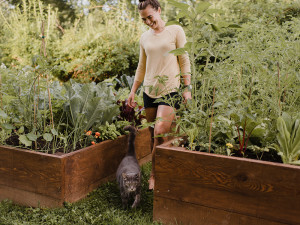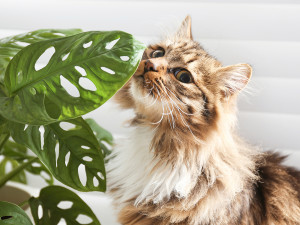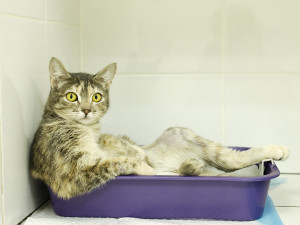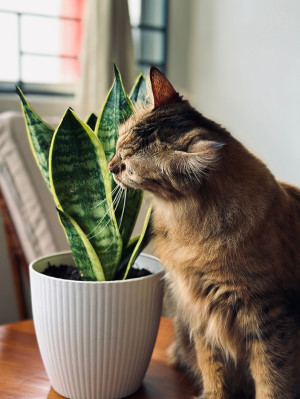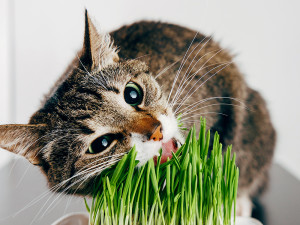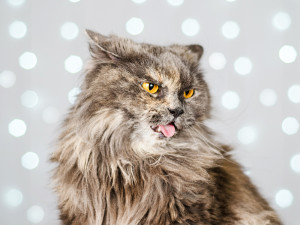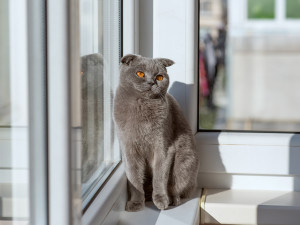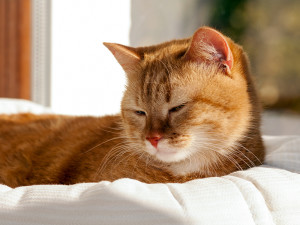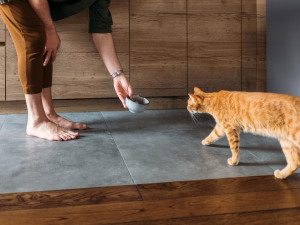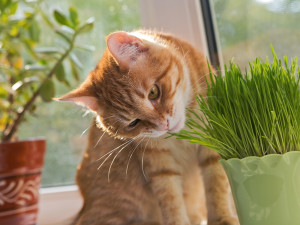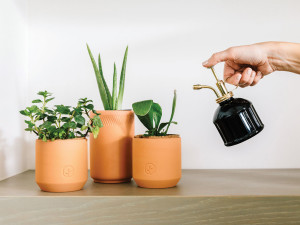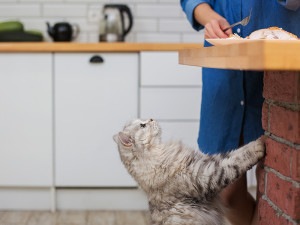Are Tulips Toxic to My Cat?
They’re pretty in your garden, but keep those hungry cats away. Here’s why.
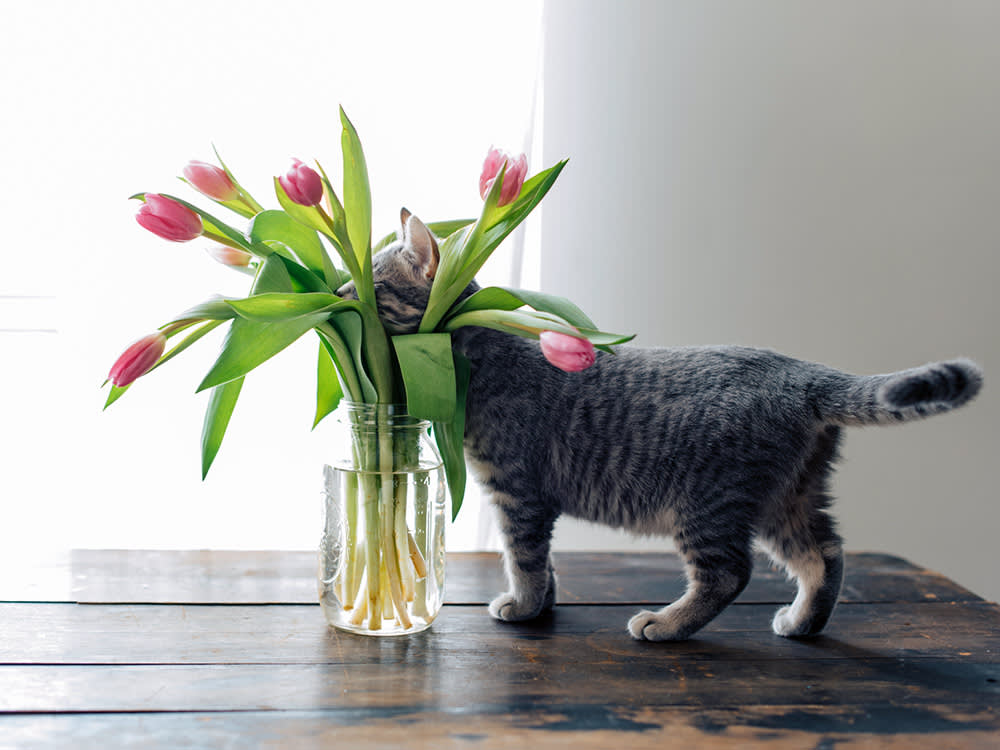
share article

Your pet wants you to read our newsletter. (Then give them a treat.)
Tulips (Tulipa genus) are beautiful plants that are unfortunately toxic to cats. All parts of the plant are toxic, but the toxin is most concentrated in the bulb. Fortunately, symptoms of toxicity are usually mild and limited to gastrointestinal signs, such as drooling, vomitingopens in a new tab, and diarrheaopens in a new tab. Cats can have more severe symptoms if they ingest a large amount of tulips, especially the bulbs. Contact a veterinarian if your cat has eaten any part of a tulip.
Why are tulips dangerous to cats?
All parts of the tulip plant contain a variety of substances that can irritate a cat’s mouth, skin, stomach, and intestines. The primary components of the plant that cause toxicity are tulipanin A, tulipanin B, and calcium oxalate crystals. Tulipanins are chemical compounds that can cause a localized allergic reaction. Calcium oxalate crystals are little jagged microscopic shards that abrade and irritate any part of the body they touch.
What should I do if my cat has eaten a tulip?
If you see your cat eat any part of a tulip or see evidence that they gnawed on some of the plant, contact your veterinarian or an animal poison control center. They can help determine how dangerous the amount eaten is and tell you what signs to watch for.
Generally, a cat that has eaten a leaf or two is not expected to have symptoms beyond mild oral irritation and gastrointestinal upset. Cats that eat a large amount of the plant or any part of the bulb may develop more severe signs and require veterinary care. Any cat that is vomiting multiple times, acting depressed, having severe diarrhea, or not eating should see their vet to make sure they get the treatment they need.
Diagnosing plant poisoning in cats
The best way to diagnose most plant toxicities is to observe the cat eating the plant or to find evidence that the plant has been chewed on. Observant cat parents may note pieces of flowers or leaves in a pile of vomit. This is because vomiting often occurs quickly (within minutes) after ingestion of irritating plant material. If your cat is sick for unknown reasons, be sure to let your vet know if they have access to tulips and check the plant carefully for signs of disruption.
Symptoms of plant poisoning in cats
Most tulip ingestions by cats involve eating just a leaf or two, possibly due to curiosity. Cats should find eating this plant irritating to their mouth and stomach, so most stop after just a bite. Eating a small amount of tulip may cause mild symptoms like:
Oral irritation
Drooling
Vomiting
Diarrhea
Cats aren’t known for eating large amounts of plant matter or chewing on the bulbs of plants, but some cats can be weird or maybe just extra bored. A large ingestion of tulip can result in these more severe symptoms:
Bloody diarrhea
Weakness
Elevated heart rate
Decreased blood pressure
Tremors
Seizures
Intestinal obstruction
Difficulty breathing (due to swelling of the mouth or throat)
Skin irritation
Abdominal pain
Treatment
Treatment for tulip ingestion is usually based on the cat’s symptoms. Cats that do not show symptoms or act normally after vomiting once do not generally require treatment. Veterinary evaluation is recommended for cats known to have eaten a large number of leaves or flowers or to have ingested any part of the bulb. If appropriate, inducing vomiting to help empty the stomach may be recommended to prevent more severe symptoms from developing.
Cats that are showing persistent gastrointestinal symptoms could require supportive care to help with nausea and dehydration. This often involves the administration of fluids (either beneath the skin or through an IV catheter) and anti-nausea medications. Cats showing severe symptoms may need hospitalization and intensive care.
How to prevent plant poisoning
The best way to prevent plant poisoning is to keep toxic plants like tulips away from your cat. Because tulips are often planted in springtime gardensopens in a new tab, keeping your cat indoors is the best way to prevent them from eating unknown plants. If you bring tulips into your house or have a bag of bulbs that you’re saving for the next planting season, make sure that your cat has no possible access to the area where the plant or bulbs are kept.
Are all parts of tulips poisonous to cats?
All parts of the tulip plant are poisonous to cats. The toxic components are most concentrated in the bulb of the plant, but the flowers, stem, and leaves still contain toxins that can make cats sick. Contact your veterinarian if you think your cat has eaten any part of a tulip.
How do I stop my cat from eating tulips?
Cats can’t grow tulips on their own, so stopping your cat from eating them is as simple as keeping them out of your home. If your cat must be outdoors or if you must have tulips in your house, fence or block off the area with the plants. Cats are smart and sneaky, so the protection must be solid to prevent mischief. Cats can be trained to avoid certain plants, but just keeping tulips away from them is much easier.
The bottom line: Are tulips poisonous for my cat?
Tulips are poisonous to cats. Most cats do not eat enough of the plant to cause symptoms beyond some mild GI upset, but the potential for severe toxicity is present for cats that ingest a lot of plant material. It’s best to keep tulips out of your cat’s living area.
Other plants that are safe for cats
Roses: Roses are a favorite of romantics everywhere and perfectly safe to give to your favorite cat lover. Well, mostly safe — watch out for the sharp thorns on freshly picked flowers.
Orchids: Orchids are also non-toxic to cats and make for a great addition to any garden or bouquet.
Boston Fernopens in a new tab – These verdant hanging plants can help make any room feel more cozy and are cat-safe. Well, safe for cats, not necessarily from cats that may amuse themselves by batting at their dangling fronds.
Other plants that are dangerous for cats
Liliesopens in a new tab: Most varieties of lily are very dangerous for cats and can cause acute kidney failure. Early signs of problems include vomiting and abdominal pain, but symptoms can progress to kidney failure quickly. All parts of the lily plant (including the pollen) are toxic to cats.
Azaleasopens in a new tab: Azaleas contain a chemical that can cause vomiting, diarrhea, heart arrhythmias, low blood pressure, seizures, and coma in cats. Cats should be kept away from these beautiful plants.
Daffodils: Similar to tulips, this bulb plant carries toxins that cause vomiting, diarrhea, elevated heart rate, and seizures. Their bulbs also contain the highest concentration of toxic components and pose the biggest risk to cats.
FAQs (People also ask):
What happens if a cat eats a tulip?
Cats that eat a small amount of tulip often develop mild gastrointestinal symptoms like drooling, vomiting, or diarrhea. Cats that eat a large amount of the plant can develop more severe symptoms like abdominal pain, low blood pressure, weakness, or tremors.
Can cats eat tulips safely?
Cats cannot eat tulips safely. All parts of the tulip, including the bulb, stem, leaves, and flowers contain substances that irritate the mouth, skin, and gastrointestinal tract.
Are tulips poisonous to cats if they smell them?
Tulips are not toxic to cats if they smell them because the substances that cause toxicity are contained within the plant and not emitted. Cats that rub on tulips may experience some localized skin irritation, though.
References:

Dr. Bartley Harrison, DVM
Dr. Bartley Harrison, DVM is a small animal veterinarian based in North Carolina who has practiced emergency medicine since graduating from the Texas A&M College of Veterinary Medicine. His primary interest areas include pain management, cardiology, and the treatment of shock.
He is a member of the Veterinary Emergency and Critical Care Society, American Veterinary Medical Association, and American Medical Writers Association. In addition to his clinical work, he writes pet health articles to help provide accurate information for both new and experienced pet parents. When he’s not working, he enjoys cooking, traveling, reading, and going on adventures with his dog.
Related articles
![Uncomfortable looking gray cat sitting on a window sill]() opens in a new tab
opens in a new tabShould Your Cat Go to the ER?
Here are six good reasons to haul tail to the emergency room.
![Red cat with squinted eyes laying in a basket closeup]() opens in a new tab
opens in a new tab6 Ways Your Cat Could Tell You They Are in Pain
Here are all the way your kitty is trying to tell you they’re hurting.
![Profile view of a man giving a cat food to eat]() opens in a new tab
opens in a new tabWhy Is My Cat Not Eating? Causes, Symptoms, and Treatment
A veterinary nutritionist explains why your cat isn’t eating and how to increase their appetite.
![Cat sitting on a window sill eating cat grass]() opens in a new tab
opens in a new tabSweet Greens: The Best Cat Grass Grow Kits
Not to be confused with catnip (or other buds).
![A Terracotta kit with planters.]() opens in a new tab
opens in a new tabThis Catnip Grow Kit Provides Your Cat With a Houseplant They Can Actually Eat
If your loved ones with cats can’t keep a plant alive, this is the gift for them.
![Cat asking for human food from counter]() opens in a new tab
opens in a new tab10 Human Foods That Are Safe for Cats
Good news for your begging cat: Some of your favorite snacks are safe to share.
